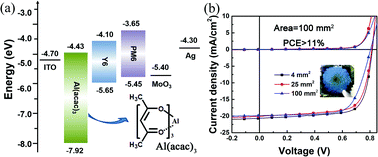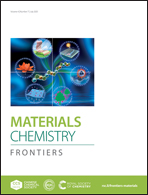Novel cathode buffer layer of Al(acac)3 enables efficient, large area and stable semi-transparent organic solar cells
Abstract
The electrode buffer layer plays a more crucial role in semi-transparent organic solar cells (ST-OSCs) than in opaque devices due to the additional requirements of the average visible transmittance (AVT) and color rendering index (CRI) besides the power conversion efficiency (PCE). Herein, we developed a novel cathode buffer layer aluminum(III) acetylacetonate (Al(acac)3) via mild spin-coating with a post low temperature heat treatment process. Studies show that the Al(acac)3 film possesses outstanding optical features and a suitable energy level. Namely, the absorption of an Al(acac)3 film with a thickness of 10 nm is as low as 1% and the transmittance is high, up to 95%, in the visible and near infrared regions, guaranteeing full absorption of the photoactive layer and a high CRI for ST-OSCs; and the suitable energy level ensures a smooth electron transport and collection process. By introducing the Al(acac)3 film in ST-OSCs, the devices based on PM6:Y6 yield an efficiency of 12.41%, an AVT of 25.33% (from 370 nm to 740 nm) and a CRI of 94.6. Encouragingly, the large-area ST-OSC of 100 mm2 with the Al(acac)3 buffer layer yields an efficiency of 11.28%. Further, the long-term stability of ST-OSCs shows that the device with encapsulation retains 60% of the initial PCE over 60 hours of continuous illumination. The results indicate that Al(acac)3 is a promising cathode buffer layer for fabricating efficient, large area and stable semi-transparent organic solar cells.



 Please wait while we load your content...
Please wait while we load your content...